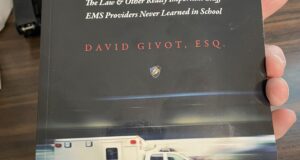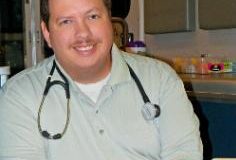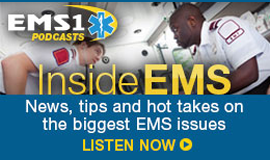“So there we were, a crowd of anxious onlookers gathered around, me and my trusty sidekick kneeling next to a sweet little grandma in the throes of VF, and us without an AED or even a CPR pocket mask. And right then, I turned to my compadre and said, “Partner, this is the kind of call where legends are made…”
**********
Okay, so maybe that wasn’t exactly how it happened, but since that’s the way most EMS war stories begin, why break with tradition?
TOTWTYTR and I left EMS Today 2011 after the exhibit hall closed Saturday, and pointed ourselves north to Philly to meet some blogger friends for dinner. After a superb meal and a couple hours of riotously funny conversation, we continued on our way, stopping overnight in Edison, NJ.
Sunday morning, before continuing our trek to Massachusetts, we stopped at a local diner for breakfast. Since my vow to change my eating habits for the better, breakfast for me has usually been a cereal bar and a piece of fruit. This morning, however, I decided that man cannot live on twigs and berries alone, so I indulged myself with scrambled eggs and bacon, with the substitution of Egg Beaters being my only concession to healthy eating.
TOTWTYTR, being the supportive friend that he is, had the friggin’ French toast, liberally smothered in powdered sugar and maple syrup.
So, as I morosely pushed my imitation eggs around my plate and wished a four-vessel bypass on my friend, we heard a commotion behind us.
“Call 911!” came an urgent voice, echoed shortly thereafter by a more authoritative one, this time with the force of command, “CALL 911.”
“Sounds like they could use some help,” TOTWTYTR observed laconically.
“Sounds like it,” I replied coolly. “Shall we?”
Because you know, it’s important to be laconic and cool when you’re a pair of trauma fighting superheroes.
So, following EMS Axiom #4 (paramedics do not run), we moseyed over to the booth in question. Well, I moseyed. TOTWTYTR, being the senior medic in the room, chose to swagger.
As we shouldered our way through the knot of waitresses and onlookers, we identified ourselves as off-duty paramedics. “Thank God,” one of them breathed, and the crowd parted to reveal an elderly woman slumped over in the booth, eyes open and unfocused, breathing agonally.
TOTWTYTR, not one to mince words, suggested, “Let’s get her out of the booth and onto the floor where we can manage her airway.”
As we did just that, I noticed an elderly gentleman sitting in an adjacent booth, watching us fearfully, tears welling in his eyes. Her husband.
A waitress stood behind him, fluttering hands gently placed on his shoulders in a comforting gesture, but her eyes had more tears in them than his.
I slid my fingers up the sleeve of her coat, feeling for a radial pulse. Finding none, I glanced up at TOTWTYTR, who was also searching in vain for a carotid pulse.
“Got anything down there?” he asked hopefully, and I shook my head. “Okay, time to start compressions.”
It occurred to me then that, for the 10+ years we’ve been friends, this was the first time TOTWTYTR and I had ever worked a call together. Despite that, we were already completing each other’s thoughts.
As I started compressions, grimacing at that initial crunch of rib cartilage separating in an elderly person, he said, “No pocket mask… let’s just do compression-only CPR until help gets here.”
I interrupted my mental compression count to reply, “I’ll call for a switch after 200, and we’ll swap positions. Just keep monitoring her airway.”
As I was nearing my 100th compression, I felt an urgent tug at my left elbow. A voice asked, ”What compression are you on?”
By way of reply, I started counting aloud, “Ninety-four, ninety-five, ninety-six…”
“Stop!” the voice blurted, and I turned my head to see an attractive woman in her mid-thirties, kneeling on the opposite seat of the booth. “You’re only supposed to do thirty compressions at a time!” she admonished.
Rather than explain the differences between dual-rescuer CPR for healthcare providers and compression-only CPR for laypersons, I simply smiled reassuringly and replied, “It’s okay, we’re both paramedics and CPR instructors.”
Apparently, that wasn’t adequate explanation.
She drew herself up haughtily, and retorted, “I took CPR just six months ago, and I know you’re supposed to give 30 compressions and 2 ventilations.”
So I retorted, just as haughtily, “Do you know who you’re talking to? DO YOU?? You’re talking to Ambulance Driver and muhfuckin’ Too Old To Work, beeyotch!”
Okay, so maybe I didn’t say exactly that. Instead, forcing myself to remain polite, I kept the confident smile on my face and used my Paramedic Voice. “Thanks for your assistance, Ma’am, but the standards changed only four months ago. You can rest assured that the paramedic CPR instructors know how to do CPR.”
TOTWTYTR suppressed a chuckle, and said, “That’s two minutes. Ready to switch?”
As I slid into position at the woman’s head, both of us noticed that her eyes had begun to focus, and that her breathing had improved enough to notice visible chest rise.
I don’t think I’ll ever get used to seeing that.
They teach you in CPR class that breathing becomes agonal within seconds following the onset of ventricular fibrillation, and truly that describes this woman’s respiratory effort. Her rate, however, was 12, perhaps 14 breaths per minute.
That’s within normal range for an adult.
I’ve seen healthcare providers mistake the onset of VF for a seizure, as the patient arched their back and spasmodically jerked. Only checking a pulse clued the nurses in to the fact that we were dealing with a lethal arrhythmia and not a seizure.
I’ve also done CPR on witnessed arrests where our compressions provided enough brain perfusion to allow the victim to open his eyes, look at you when his name was called, and nod his head in answer to questions. The moment you stopped, however, those eyes lost their focus, and the patient quickly lost consciousness.
Apparently, that was the case with this woman, because as we vainly searched for a pulse, her breathing quickly declined and her eyes rolled back once again.
Muttering under his breath, TOTWTYTR resumed compressions, and I maintained a head-tilt, chin-lift in hopes that a little passive oxygenation might be possible with the changes in intrathoracic pressure brought about by chest compressions.
Shortly after beginning our second cycle of compressions, a set of AED pads appeared in my field of vision, held by a police officer whose hands were shaking so badly that he could barely pull the backing paper off the pads. TOTWTYTR looked at the shaking hands, followed them up to the officer’s face, and made his judgment.
“It’s okay,” he said gently, “we’ve got it.” Taking the pads from the grateful officer, he quickly lifted the woman’s blouse and applied them. As the AED analyzed the rhythm, he rocked back on his haunches to rest.
“Shock advised,” purred the AED in its telephone operator’s voice. “Stand clear. Push the SHOCK button.”
“Everybody clear!” called TOTWTYTR, waving his hand over the patient.
Nothing happened.
I looked up to see the cop standing three feet away, the SHOCK button on the AED flashing an insistent red.
“I think he’s waiting on you to do it,” I said softly, nodding at the cop. TOTWTYTR twisted around to look at the abandoned AED, then up at the cop. Shrugging, he pressed the button, the woman’s back arched in spasm, and we were already shifting positions before her torso relaxed onto the floor once again.
TOTWTYTR resumed compressions, waving off my offer to switch places. “I’m good,” he grunted. “I had just started when we stopped to shock, anyway. See if the cop has a BVM.”
The cop, overhearing him, unzipped a side pocket of his BLS bag, ripped the BVM out of its plastic wrapper, and thrust it at me.
Naturally, the mask was not attached to the bag. Story of my life.
I got up, stepped behind TOTWTYTR and fished the mask out of the BVM wrapper. I settled in at the woman’s head, tilted her head back, and nodded at my partner.
“Go ahead,” he grunted, hands poised just above the woman’s chest. I delivered two breaths, and as soon as the second one was in, he resumed compressions, counting aloud this time.
See what I mean about completing each other’s thoughts? It couldn’t have been a more seamless transition into two-rescuer CPR, with barely a word exchanged between us.
I wish my BVM technique had been as flawless, because I was missing a few breaths now and then. I dropped the BVM briefly to reposition her head, and resumed ventilations the next time the count reached 30.
Only got the first one in, damn it.
“Someone hand my partner an OPA if you’ve got one,” TOTWTYTR ordered, and presently a medium adult Berman-type OPA was handed to me. The arm that held it was clad in turnout gear.
I looked up at the firefighter holding the OPA. “If you’ll hand me your tubing, I’ll hook you up to oxygen,” he offered. Gratefully, I handed him the BVM’s oxygen connector, and he opened the flow meter to 15 liters.
Unfortunately, inserting the OPA proved more difficult, because our patient was trismic. I managed to wedge the OPA briefly between her molars, but since I wasn’t wearing gloves, I was somewhat reluctant to stick my thumb in her mouth to perform and tongue-jaw lift.
Besides, adding a severed thumb to the mix would only complicate her airway issues. So, I carefully repositioned her head and resumed ventilations, sans OPA. With a little more attention to detail, I was able to ventilate her more effectively.
As the AED counted down, “Analyzing in 5, 4, 3, 2, 1… stop compressions… do not touch the patient…” I looked up to see more professional rescuers in the room, including several not wearing turnout gear.
Problem was, they were all on the wrong side of a knot of onlookers, and were having little success in making their way to the patient, doing it the polite way.
As TOTWTYTR pushed the SHOCK button a second time, I maneuvered into place to resume compressions. We had given several sets of compressions and ventilations when I heard that familiar voice at my left elbow, “Here, put these under her neck.”
I looked up to see our helpful bystander, the CPR critic, thrusting a six-inch stack of wet napkins at me. Resisting the urge to tell her to go boil some water, I instead thanked her for her help and laid the soggy napkins on the woman’s chest. “We’ll get right to that on the next compressor switch,” I lied.
The next time the AED started its analysis sequence, a calmer voice said, “Thanks guys, we’ll take it from here.” TOTWTYTR and I looked up to see that the BLS rescue squad had managed to maneuver their way to the patient’s side. One was already kneeling beside the AED, finger poised over the SHOCK button. A third was standing behind TOTWTYTR.
As we stood up and massaged the kinks from our lower backs, the local EMTs delivered a third shock and resumed compressions, with little wasted motion.
As we stepped back and watched the CPR ballet, for once as spectators and not participants, my buddy said laconically, “Our work here is done. Shall we wash our hands before finishing our breakfast?”
Remember how I said it was important to be cool and laconic when you’re a lifesaving superhero? Y’all make a note of that.
“Good idea,” I chuckled, and followed him to the men’s room.
As we made our way back to our table, I noticed our patient still lying there, and no one doing compressions or ventilations. I elbowed TOTWTYR.
“Check it out,” I snorted. “We do uninterrupted chest compressions right up until the professional EMTs get here, and now everyone’s busy doing anything but what they’re supposed to be…”
… and then I noticed the woman breathing, and doing a pretty fair job of it, in fact. One EMT was feeling for a carotid pulse, a triumphant grin on his face, while another was filling the reservoir on a non re-breather mask.
“Okay, well maybe they had good reason to stop compressions,” I admitted sheepishly. “Looks like they got her back.”
“Hope so,” TOTWTYTR agreed. “Witnessed arrest, CPR started immediately… maybe she’s got a fighting chance.”
When we got back to our table, the busboy had already cleared our plates. Damn it, and I was looking forward to those home fries. It seemed the fates were conspiring to keep me honest.
Our waitress, however, appeared immediately, topping off TOTWTYTR’s coffee and refilling my water glass. She was still crying, and her hands were shaking like a leaf.
“Hey,” I said softly, nodding toward the EMTs. “Look over there.”
The ALS ambulance had arrived, and they were busy packaging the patient for transport. From fifteen feet away, we could see the steady rise and fall of the woman’s chest. The waitress stared for a moment, and turned her eyes back to us.
“They got her back,” I told her. “Wouldn’t have happened if someone hadn’t had the good sense to call 911 right away.” TOTWTYTR nodded in agreement.
As we gathered our things and made our way to the cashier, it seems everyone wanted to thank us.
The cops shook our hands gratefully.
So did the firemen.
Ditto for the EMTs.
The medic from Robert Wood Johnson made it a point to duck back into the diner and give us an attaboy before she transported.
The manager of the diner refused our money, saying our breakfast was on the house. Diner patrons tugged at my sleeve, wanting to shake my hand before I left.
To be honest, it felt a little weird. And one thing I noticed; no one bothered to heap such praise and gratitude on the people in uniform who were working on her, too. There’s something wrong with that.
But something also tells me the cops, firefighters, EMTs and paramedics don’t much mind. They know that resuscitation is a team sport, and saves are a team victory.
After all, they’re professionals.
 Ambulance Driver Files A Day in the Life | Kelly Grayson
Ambulance Driver Files A Day in the Life | Kelly Grayson


